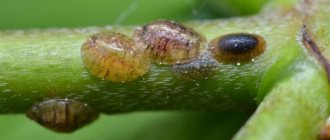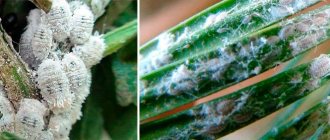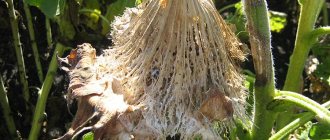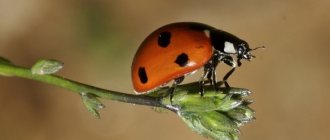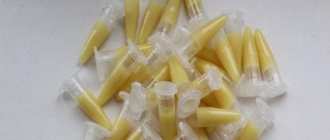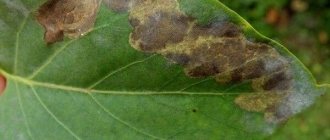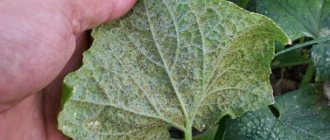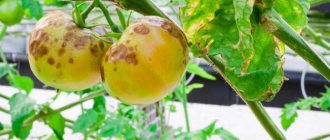Description
Podurs belong to the primitive primary wingless insects of the family Collembola . Their size varies from 0.2 mm, some types can reach 10 mm.
Poduras are very small insects.
A characteristic feature of springtails is the presence of a jumping fork , which is a growth in the back of the body; it allows some species to jump up to 3 cm in height. This feature allows you to distinguish podura from another orchid pest - the mealybug.
In the substrate of indoor plants you can usually find white or grayish colorings, sometimes with a greenish tint.
What does a fool look like?
Collembula is a small insect whose body size ranges from 2 to 10 mm. Outwardly, it is very reminiscent of a caterpillar, painted white or beige. There are also springtails or poduras of yellow, gray and even metallic shades, with transverse stripes, a marbled or dotted pattern.
On the underside of the abdomen, the collembola has a fork-shaped process, thanks to which it not only moves along the soil, but is also able to jump. In a calm state, this jumping organ tucks under the abdomen and is practically invisible. This is the most obvious sign with which even a novice florist can recognize a subura. Below is a photo of a springtail.
Conventionally, springtails are divided into the following types:
- white podars are pests that live in the upper layers of the soil; they can especially often be found in greenhouses and hothouses where humidity levels are high;
- vegetable podurs are insects that eat ornamental plantings; they are also inhabitants of summer cottages;
- mushroom podurs - this type of pest can harm young shoots, seedlings and bulbous flowers.
Photos of different types of poduras can be seen below.
Fools
On a note!
The number of springtails largely depends on the level of humidity: the higher it is, the faster the pests multiply. Over time, from the eggs laid by the female into the substrate, larvae appear, differing from adults only in size.
What is the danger?
These insects do not pose any danger to orchids, as well as other plants; they like to hide in places with high humidity. The springtail diet includes :
- Bacterial plaque;
- Mushroom mycelium;
- Seaweed;
- Mosses.
If the number of insects is too high, this indicates poor conditions for keeping the orchid associated with:
- Low temperatures;
- Poor lighting, etc.
It leads to:
- Slower orchid growth;
- Decreased immunity;
- The emergence of diseases.
Poduras, springtails, forktails
Poduras, springtails, forktails are synonymous names for the springtail species. What do they look like and how to recognize them? Insects are small in size (approximately 1-2 mm long), have an oval body, white color, and do not have wings. As for the home, they live in the soil of indoor plants, where they develop due to excessive watering, and can also appear on the surface of the water in aquariums. They are clearly visible on the soil or bottom of a flower pot.
Springtails and forktails will not cause significant harm, since they feed on plant roots that have rotted as a result of oversaturation of the earth with water. It is also worth noting that some types of springtails can rid the soil in a flower pot of small pests - worms, thereby bringing only benefits. However, if poduras reproduce, they can cause much more harm: a large number of springtails will destroy shoots and young roots.
In our article we will tell you what preventive measures you should follow to prevent springtails and forktails from disturbing your indoor plants, and what means and preparations you can use to get rid of springtails at home.
Reasons for the appearance of dura in the substrate
Springtails, as a rule, are brought into a pot with a flower along with the soil . Some insects, sensing moisture, can spread out and invade neighboring plants.
Podurs are introduced along with poor-quality soil.
The start for intensive reproduction of insects is usually too frequent and abundant watering, which can also lead to rotting and diseases of the roots.
Attention! Large colonies of springtail orchids jumping in the substrate are an indicator of constant waterlogging of the soil and an indicator of improper agricultural practices.
Their appearance indicates the need to change the conditions of maintenance and watering of the plant.
Pest on violets
Springtails are present in almost every indoor plant soil. Several miniature individuals are difficult to notice; they leave no signs of their existence. As humidity levels rise, adults begin to reproduce intensively. In damp soil, the roots rot, and rotten organic matter is the main source of food for fools. The number of springtails increases, they begin to jump, appear floating in trays of water. The damage from springtails increases at low room temperatures. Unfavorable conditions slow down the growth and regeneration of indoor plants. Even minor damage turns into serious problems.
Heavy acidifying soil in pots with violets is a violation of agrotechnical growing conditions. Some species of fools cause damage to young violet seedlings. Damaged plants become vulnerable to diseases and other pests. Springtails are also carriers of fungal spores that cause disease.
Fighting methods
Folk remedies
How to get rid of fools at home? If a small number of poduras appear in the substrate, do not rush to use chemical plant protection products; they can cause more harm to the orchid than a few insects.
When pests appear, the orchid first of all :
- Isolate to prevent the spread of dura to other plants;
- Mechanical soil cleaning is carried out.
Good results can be achieved :
- Laying out bait in the form of raw potatoes cut into pieces on the substrate around the plant. In a few days, a large number of springtails will accumulate on it, which are easy to collect and eliminate;
- When immersing a flower with a pot in water for 20 minutes. All adult individuals will float to the surface in the water, after which they are collected and destroyed.
In addition, there are a number of other home methods to combat these insects.
Herbal decoctions of medicinal herbs. These decoctions have long been prepared to combat various harmful insects:
- Flowers of chamomile, calendula, dandelion, yarrow . To prepare a decoction, add 0.5 liters of water to 20 g of dry plants, bring everything to a boil and remove after ten minutes. Cool at room temperature, filter and treat the affected plants;
- Infusion of marigolds . Faded marigolds along with the leaves are poured with hot water in a 1:1 ratio and left for two days.
After treating the orchid with herbal decoctions, you should record the date of spraying in order to repeat the procedure after 7-10 days.
Herbal infusions are made against fools.
You can also use other solutions :
- Mustard solution. To prepare the solution, mustard powder (15 g) is poured into 1 liter of hot water and infused for 2 days. The resulting preparation is sprayed onto the plant, and dry mustard is sprinkled onto the soil;
- Mulching the soil with birch wood ash . A good result in the fight against springtails is obtained after sprinkling the soil with wood ash (birch ash is best) in a layer of one or two centimeters;
- Anti-flea shampoo for animals . A solution with the addition of flea shampoo showed unexpected effectiveness. To prepare 1 tbsp. l. shampoo is dissolved in a bucket of water, the plant and substrate are sprayed. After a short time after treatment, the orchids disappear.
Important! An effective method for eliminating springtails is to replace the substrate. The orchid is replanted after thoroughly washing the roots in running warm water.
The listed measures, which are used individually or in combination, are sufficient to protect indoor plants from any number of springtails.
Fitoverm
Fitoverm is a natural pesticide that is obtained during microbiological cultivation of the producing fungus. The drug is environmentally friendly, as a result of which its effect on the orchid will be minimal:
- The insect absorbs the drug along with food , as a result of which the poison affects only mature individuals and larvae. Podura eggs remain viable after treatment with phytoverm, so after 6-7 days it is necessary to spray again;
- Fitoverm is not mixed with other insecticides or fungicides.
To spray an orchid, 2 ml of the drug is dissolved in 50 ml of water, 0.1 liter of solution is consumed per plant.
Chemicals
If it was not possible to get rid of the larvae and adults using the methods described above, then you should use chemicals. Currently, there are a number of agents that have shown effectiveness against springtails :
- Bazudin is a powdery product; a thin layer of it is scattered over the surface of the substrate. As a result, after just a few hours, springtails will no longer annoy the plant;
- Pochin - used similarly to bazudine. To increase the efficiency of the process, the scattered preparation is mixed with a small amount of earth;
- Aktara is a universal drug, used in the form of a solution, which is used to water the soil and dilute it according to the instructions;
- Mospilan – also used for treating soil against podura in the form of a solution.
Chemical agents effectively help in the fight against fools.
These drugs will help control pests in a short time .
Precautionary measures
When working with insecticides, it is necessary to comply with safety rules :
- Children and pets are not allowed near the sprayed orchid;
- Work with insecticides is carried out with gloves and a respirator;
- After finishing work, the tools are thoroughly washed and stored in a separate place;
- In case of contact with skin, the insecticide is washed off with water and detergents. If the product gets into the eyes, rinse with running water;
- It is prohibited to eat or drink while carrying out work.
Used ampoules or packaging are wrapped in polyethylene and thrown away, the remaining solution is poured down the drain.
Important! If you follow the instructions for working with the insecticide, it does not have a harmful effect on the orchid.
Main harm
Every gardener should know what podurs are, how to deal with the pest and what needs to be done to prevent their occurrence. It is no secret that even a small population can cause damage to cultivated crops. And although it is not that big, over time the colony will begin to expand and turn into a huge threat to indoor plants.
Among the main consequences that develop during the activities of subsurfaces, the following should be highlighted:
Actively eating green leaves and sucking juices from all parts of the plant. The problem progresses with high humidity and temperature conditions from 22 to 25 degrees, because in such an environment insects develop very quickly, penetrating both into the soil and inside the flowers.
- Damage to the root system, as a result of which the plant ceases to receive the optimal amount of nutrients and becomes weak.
- Increased risk of dangerous diseases and germs. By infecting individual parts of plants, podurs open the way for the development of numerous fungi, infections and other troubles.
If you do not take the necessary measures in time, then over time the indoor flower will simply die from the vital activity of the springtail.
Preventive actions
To prevent re-infection with poduras, you must :
- Buy flowers in specialized stores, which will reduce the risk of pest infection;
- Provide the orchid with good drainage and air circulation;
- Maintain the correct watering regime and optimal humidity in the room;
- If necessary, replant the orchid, while washing the pot and changing the substrate;
- Avoid excessive application of organic fertilizers.
Folk remedies for controlling podars, springtails and forktails
Folk remedies for fighting springtails are good because they are completely harmless to plants, while the use of some chemicals is dangerous. It is not difficult to combat soil pests. The following folk recipes will help you get rid of forktails and springtails at home:
- Watering. Do not water your flowers much or at all for a while. As soon as the soil loses excessive moisture, the springtails will leave the indoor plants on their own.
- Tobacco, or more precisely, dust. Sprinkle the soil in the pot with tobacco dust - and the problem will go away.
- Askofen or Citramon tablets. Prepare the solution: divide one tablet into two parts and fill one half with two to three liters of water at room temperature. Once the tablet has completely dissolved, pour the liquid over the flowers. This will prevent the reproduction of fools.
- Water. "Like water?" - you ask, if it is with its help that the fools obtain an ideal habitat. This means the following: take a deep basin or other container, place a flower pot in it and fill it with water so that it covers the top layer of soil. Once you do this, the springtails and forktails will float, and you can easily catch them from the water surface.
- Potato. Take a couple of pieces and cut them in half. Place the inner side on the soil in the pot. After a few hours, you will see how the fools came to the surface and settled on parts of the potatoes. You can carefully remove the vegetable halves along with the insects. We recommend repeating the procedure, since a one-time use will not destroy all the poisons at once.
- Yarrow. Water the soil with a tincture of this herb and the springtails will disappear.
- Hot pepper. Here the recipe is the same as with yarrow: use hot pepper infusion when watering.
- Mustard. Sprinkle the powder over the surface of the soil and the problem will disappear.
- Potassium permanganate. It is necessary to prepare the solution in a transparent container: pour 2-3 liters of warm water, dip the edge of a toothpick into the liquid, then dip this edge into potassium permanganate, stir thoroughly. Pour the resulting solution and settled water into the watering container. You can water indoor plants.
Recommendation: follow safety precautions when working with potassium permanganate, avoid getting it on your skin.
External signs of damage
It is quite easy to notice that fools have grown on a houseplant. These are small white, cream-colored caterpillars (some species may have a green, silvery tint) that can be seen with the naked eye. They have antennae.
Springtails are usually found in small quantities in any soil. But against the background of high humidity, they can begin to actively reproduce, which will negatively affect the indoor plant.
If silt appears on the surface of the soil, then soon you can expect that podurs will appear in large numbers. Wet soil, when the plant begins to slowly rot from excessive moisture, is an ideal environment for the development of these parasites. It is important to understand that the signs of damage, especially in the first stages, will not be noticeable: after all, the root system is mainly affected. But soon the plant will begin to wither, weaken, and the leaves will turn yellow. However, podurs operate on the soil surface and are easy to notice, even without signs of obvious damage to the plant.
How to deal with an invasion
Preventive measures
Moisture attracts springtails
When looking for damp places, springtails from the street can get into a damp room, which means this needs to be prevented. It is difficult to “live” such a tenacious insect, but not to create favorable conditions for it – perhaps the following measures will help with this:
- Ventilating the room will reduce air humidity.
- How to get rid of springtails in the bathroom and basement? First of all, install fans and clean with soap or soda solution.
- Eliminate possible sources of mold or mildew (leaking faucets, faulty old water and sewer pipes, cracked window frames or wooden window sills).
- Disinfection of the toilet room with chlorine-containing products.
- When watering indoor plants, do not exceed the watering norm and make sure that water does not stagnate in the flower trays, and that the lump of earth in the pot does not resemble liquid mud. If this happens, drain the excess water, place a sponge on the ground for a while, and then let the soil dry.
Important! When replanting indoor plants, do not forget about good drainage to avoid stagnation of water and rotting of roots or organic matter that is part of the soil mixture. If tea leaves, sawdust or dry leaves were added to the soil, replace this mixture completely. Fungus and mold easily develop in such components, which is food for collembola.
People against springtails
If preventive measures do not help prevent the appearance of insects, then the “enemy” will have to be destroyed. The safest are traditional methods, so you need to start with them.
A small population can be destroyed with improvised means
- Wood ash is an excellent control method, but it is not suitable for all indoor plants. It is strictly forbidden to use on azaleas, hydrangeas, camellias (they grow on acidic soils). Instead of ash, the ground around them is sprinkled with mustard powder.
- Insecticidal plants. It is recommended to water the soil around the flowers with infusions of hot pepper or yarrow.
- A weak solution of potassium permanganate will help cope with insects.
- The following manipulations will help you get rid of springtails in your apartment: place a flower pot in which insects are found in a bucket of water. After a while they will float to the surface - you need to catch them with your hands and destroy them.
- A very simple and, according to reviews from Internet users, an effective way to combat insects: place the cut half of a potato on the ground in a flower pot, cut side down, leaving for several hours. Then, carefully remove the potato, destroy the gathered springtails and set the “trap” again. Wet potato slices are an excellent treat for pests.
- Another elementary way. Dissolve 2-3 tablets of Citramon or Askofen in two liters of water and pour the solution onto the ground around the flower. The plant is not harmed.
Podura - species (species and information about it)
White Podura (springtail)
This insect most often lives on ornamental plants. In small quantities it does not harm the house plant, but in conditions of high humidity the colony begins to actively multiply. It can be found not only in potted crops, but also when growing cucumbers and spinach, asters.
Mushroom fool
Not only a dangerous plant pest, but also a parasite that often harms champignons. Individuals are distinguished by a yellow or purple body tint. Among plants, it affects various types of salads and beans, cabbage, and bulbous flowers (daffodils, tulips).
Folk remedies for controlling podars, springtails and forktails
Folk remedies for fighting springtails are good because they are completely harmless to plants, while the use of some chemicals is dangerous. It is not difficult to combat soil pests. The following folk recipes will help you get rid of forktails and springtails at home:
- Watering. Do not water your flowers much or at all for a while. As soon as the soil loses excessive moisture, the springtails will leave the indoor plants on their own.
- Tobacco, or more precisely, dust. Sprinkle the soil in the pot with tobacco dust - and the problem will go away.
- Askofen or Citramon tablets. Prepare the solution: divide one tablet into two parts and fill one half with two to three liters of water at room temperature. Once the tablet has completely dissolved, pour the liquid over the flowers. This will prevent the reproduction of fools.
- Water. "Like water?" - you ask, if it is with its help that the fools obtain an ideal habitat. This means the following: take a deep basin or other container, place a flower pot in it and fill it with water so that it covers the top layer of soil. Once you do this, the springtails and forktails will float, and you can easily catch them from the water surface.
- Potato. Take a couple of pieces and cut them in half. Place the inner side on the soil in the pot. After a few hours, you will see how the fools came to the surface and settled on parts of the potatoes. You can carefully remove the vegetable halves along with the insects. We recommend repeating the procedure, since a one-time use will not destroy all the poisons at once.
- Yarrow. Water the soil with a tincture of this herb and the springtails will disappear.
- Hot pepper. Here the recipe is the same as with yarrow: use hot pepper infusion when watering.
- Mustard. Sprinkle the powder over the surface of the soil and the problem will disappear.
- Potassium permanganate. It is necessary to prepare the solution in a transparent container: pour 2-3 liters of warm water, dip the edge of a toothpick into the liquid, then dip this edge into potassium permanganate, stir thoroughly. Pour the resulting solution and settled water into the watering container. You can water indoor plants.
Recommendation: follow safety precautions when working with potassium permanganate, avoid getting it on your skin.
Where does it live and what harm does it cause?
Collembola loves a humid environment, so it lives where it is abundant. In general, the insect can be observed in flower pots where plants are over-watered. Stagnant water in the pan is an environment for its development. But flower growers should not be afraid; they will not harm the plant if you manage to get rid of them in time.
In small numbers, podras even provide benefits by feeding on rotten organisms. Therefore, if houseplants are fertilized, for example, with the remains of tea leaves, be careful to ensure that insects do not appear and multiply. Since, having reached a large number, they, in search of food, begin to actively feed on small shoots of the root, young shoots, which can lead to a slowdown in the growth of the flower, the entry of pathogenic bacteria into the “wounds” and its subsequent death.
Take a closer look, maybe the “booger” that was taken away in the bathroom looks like one of these
Important! When watering indoor plants, you need to pay attention to the amount of water in the ground. This especially applies to orchids, violets, and gloxinias.
In addition to flower pots, the moisture-loving springtail reproduces well in other areas of the apartment and private house where there is high humidity - shower room, bathtub, toilet. They can enter the apartment through ventilation holes, cesspools, and greenhouses. You can see jumping insects in places where mold and mildew are developing.
Why are springtails dangerous for plants?
If springtails appear in the plant, even in small quantities, you need to reconsider the basics of caring for the plant. It is possible that it is over-watered, water stagnates in the pan or the soil itself. Springtails in small quantities will not harm a houseplant. But if there is not enough food, they can begin to feed on the roots, which will lead to their rotting.
Most often, springtails can be found in the earthen coma of such indoor plants as violets, gloxinias, and orchids.
The period when the room temperature is low and the plant stops its growth will be dangerous for the plant. Then the flower does not always have the strength to naturally regenerate even parts of the plant that are not severely damaged by the springtail; such affected areas become “open gates” for various kinds of flower infections.
Springtails can cause serious damage to plants in greenhouses or greenhouses. There is high air humidity, which contributes to the rapid reproduction of parasites and their active feeding not only on the root system, but even on young stems and shoots.
Poduras, springtails, forktails
Poduras, springtails, forktails are synonymous names for the springtail species. What do they look like and how to recognize them? Insects are small in size (approximately 1-2 mm long), have an oval body, white color, and do not have wings. As for the home, they live in the soil of indoor plants, where they develop due to excessive watering, and can also appear on the surface of the water in aquariums. They are clearly visible on the soil or bottom of a flower pot.
Springtails and forktails will not cause significant harm, since they feed on plant roots that have rotted as a result of oversaturation of the earth with water. It is also worth noting that some types of springtails can rid the soil in a flower pot of small pests - worms, thereby bringing only benefits. However, if poduras reproduce, they can cause much more harm: a large number of springtails will destroy shoots and young roots.
In our article we will tell you what preventive measures you should follow to prevent springtails and forktails from disturbing your indoor plants, and what means and preparations you can use to get rid of springtails at home.
